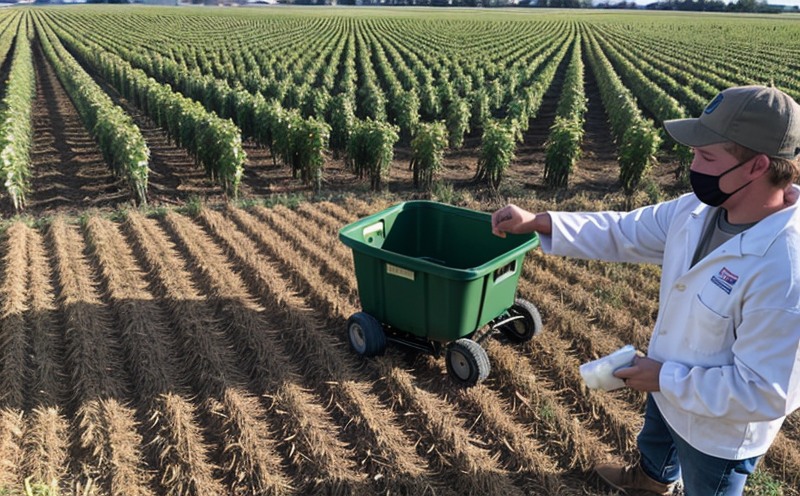Controlled Atmosphere Storage Testing
In the agricultural and forestry sectors, controlled atmosphere storage (CAS) is a critical post-harvest handling technique used to extend the shelf life of fruits, vegetables, grains, and other harvested products. CAS involves modifying the levels of oxygen (O2) and carbon dioxide (CO2) in an enclosed environment to slow down respiration processes and minimize quality losses during storage.
The primary goal of CAS testing is to ensure that stored produce remains viable, safe for consumption, and meets the stringent quality standards set by regulatory bodies. This service plays a pivotal role in maintaining product integrity, enhancing marketability, and ensuring compliance with international food safety regulations like ISO 21784:2019 and ISTA (International Safe Transit Association).
During CAS testing, various parameters are monitored to optimize the storage environment:
- Oxygen concentration
- Carbon dioxide concentration
- Air temperature
- Air humidity
- Product moisture content
The test begins with careful selection and preparation of the specimen, which is then placed in a controlled atmosphere chamber. The chamber's environment can be adjusted to simulate different conditions that might occur during storage, such as high or low temperatures, varying levels of humidity, and fluctuating oxygen and carbon dioxide concentrations.
Once the test begins, the following steps are taken:
The specimen is placed in a controlled atmosphere chamber where the parameters are adjusted to specific conditions based on the product type and desired outcome.
The chamber's environment is monitored continuously using high-precision sensors. This monitoring includes real-time tracking of oxygen, carbon dioxide, temperature, and humidity levels.
Data collected during the test period is analyzed to determine the optimal conditions for storage. The analysis considers factors such as respiration rate, ethylene production, and physical changes in the product over time.
The results of the CAS testing are used to fine-tune future storage protocols, ensuring that products remain fresh and safe for longer periods without compromising quality or safety.
Understanding the intricacies of controlled atmosphere storage is essential for maintaining high-quality produce. By leveraging this testing method, agricultural and forestry stakeholders can enhance their supply chain efficiency and meet increasingly stringent international standards for food safety and quality assurance.
Industry Applications
Controlled atmosphere storage testing finds extensive application in the post-harvest handling of a wide range of agricultural products. This service is particularly valuable for perishable commodities such as fruits, vegetables, grains, and nuts, which are most susceptible to quality degradation during storage.
- Fruits: Apples, pears, avocados, and citrus fruits benefit greatly from CAS due to their high respiration rates. Properly controlled atmospheres can extend shelf life by reducing the rate of decay and maintaining optimal moisture content.
- Vegetables: Leafy greens like lettuce and spinach are ideal candidates for CAS storage because they lose quality quickly when exposed to air. Controlled atmospheres help preserve their crisp texture and vibrant color.
- Grains: Controlled atmosphere storage is used to protect grains from moisture absorption, mold growth, and insect infestation during long-term storage.
- Nuts: CAS helps in maintaining the natural oils and flavors of nuts by reducing exposure to oxygen, which can lead to rancidity and off-flavors.
In addition to fresh produce, controlled atmosphere storage testing is also crucial for the forestry industry. Controlled atmospheres are used to store timber products like logs and sawn wood under optimal conditions to prevent warping and other quality issues that arise from improper handling.
For R&D engineers in these sectors, CAS testing provides valuable insights into product behavior under different environmental conditions. This knowledge is instrumental in developing new storage methods and improving existing protocols to enhance the overall quality of agricultural and forestry products.
Quality and Reliability Assurance
The reliability and accuracy of controlled atmosphere storage testing are paramount for ensuring product integrity and safety. Here, we outline some key factors that ensure the quality of this service:
- Sophisticated Instrumentation: The use of advanced sensors and data loggers ensures precise measurement of oxygen, carbon dioxide, temperature, and humidity levels.
- Data Analysis: Robust software tools are used to analyze collected data, providing actionable insights into the optimal storage conditions for each product type.
- Standard Compliance: Ensuring compliance with international standards such as ISO 21784:2019 and ISTA is crucial. These standards provide a benchmark for quality assurance in controlled atmosphere storage.
- Reproducibility: The ability to consistently reproduce results across multiple tests ensures that the service remains reliable and trustworthy.
In addition, regular calibration of instruments and adherence to best practices in specimen preparation further enhance the reliability of controlled atmosphere storage testing. By maintaining high standards throughout the process, we ensure that our clients receive accurate and consistent results.
International Acceptance and Recognition
The acceptance and recognition of controlled atmosphere storage testing extend beyond national boundaries, with international standards playing a crucial role in ensuring consistency and reliability. ISO 21784:2019 provides guidelines for the design, construction, operation, and maintenance of controlled atmosphere storage facilities.
ISTA also sets forth specific protocols for testing and certification processes, which are widely accepted across global markets. Compliance with these standards demonstrates a commitment to quality and safety, enhancing market credibility and consumer trust.
Many countries have adopted ISO 21784:2019 as the benchmark for controlled atmosphere storage facilities. This recognition ensures that products stored under such conditions meet international standards of quality and reliability, facilitating seamless trade across borders. For instance, the European Union (EU) has incorporated these guidelines into its regulatory framework, ensuring consistent application within member states.
The acceptance of controlled atmosphere storage testing is further bolstered by its role in meeting food safety regulations set forth by organizations like the World Health Organization (WHO). By adhering to these international standards, stakeholders can ensure that their products are safe for consumption and comply with global market demands.





